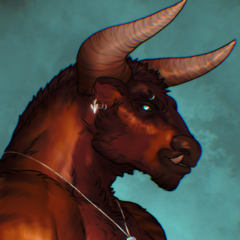More actions
From the far north stampede the Urlan, a society of beast-folk that roam the wilds, lording over all manner of beasts and creatures with their unrivaled hunting skills and large size. Urlan are a relatively rare sight, and much of their existence remains a mystery to many, even though the Urlan have been around for millennia. With their formidable size and high aggression in their natural territories, many of the lands the Urlan inhabit in little more than roving clans or tribes, have been declared off-limits by surrounding nations due to the danger the Urlan pose. Yet, these lands are equally home to many unraveled mysteries and treasures, drawing prospectors and adventurers alike to the frozen wastes. Many of them perish in these inhospitable lands at the hands of the Urlan, while others join their ranks and are transformed into the very beast-folk that hunted them. The Urlan are perpetually caught in a mental struggle between their past lives as Ailor or Elves, and their new lives as the savage yet noble Urlan. Even those who return to Regalia have trouble soothing to peace their call of the hunt and instinct-led behavior, with the rigid lifestyles of the Imperial capital. Much of what it means to be Urlan, is to discover one's self and one's own role in a strange society, and how changes to one's mind affect the true self.
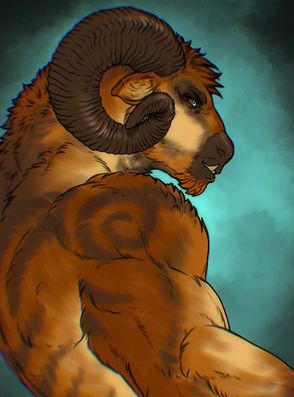
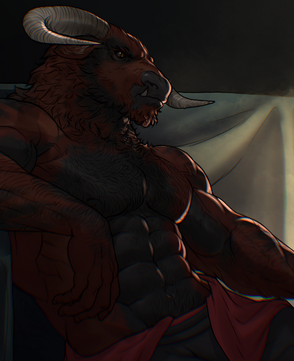
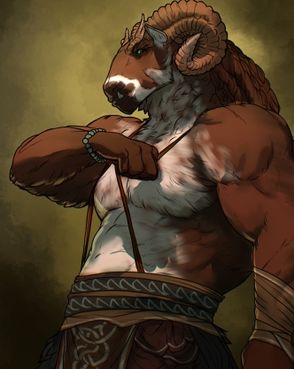
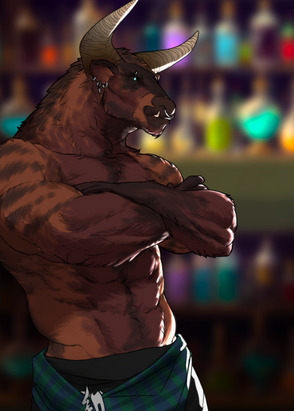
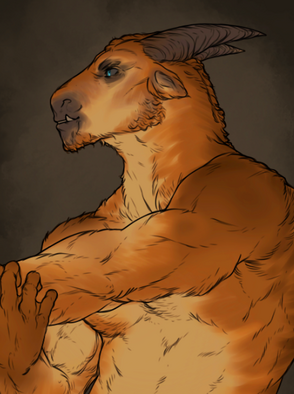
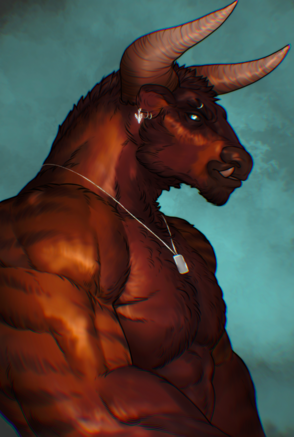
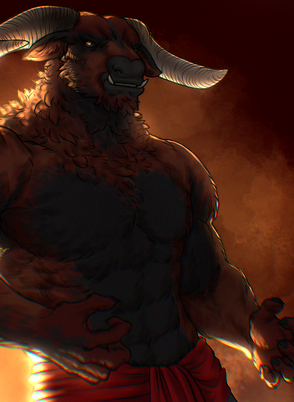
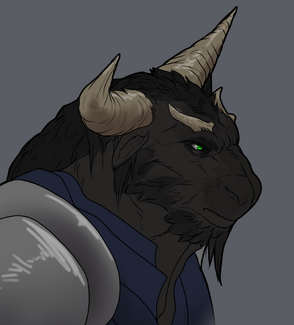
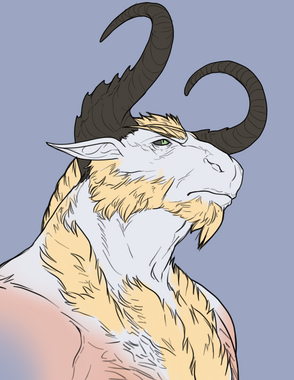
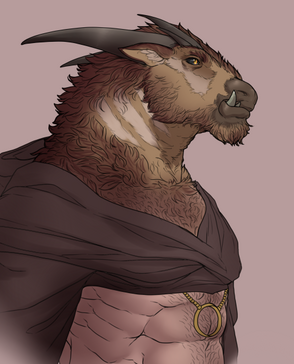
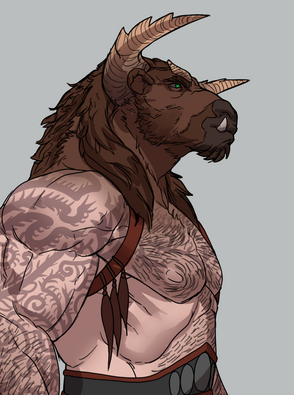
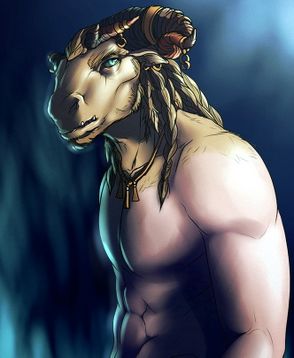
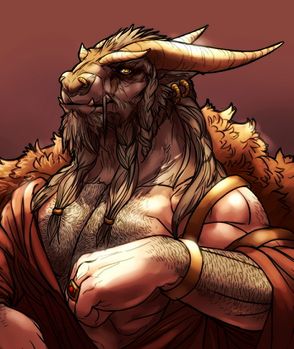
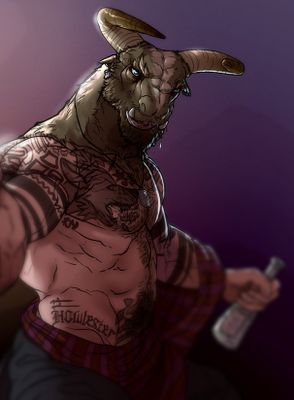
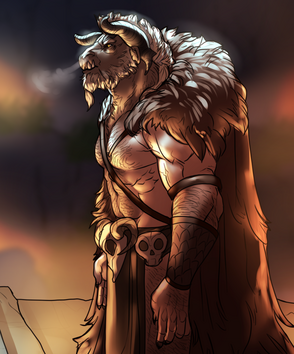
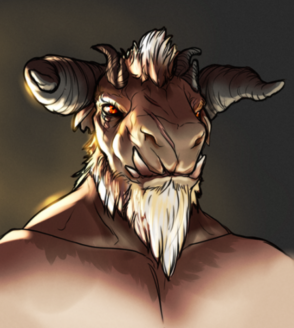
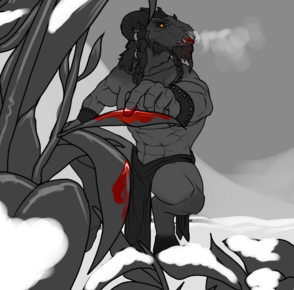
Design
At first glance someone might mistake the Urlan for yet another group of Asha, but there are very distinct differences. Firstly, Asha are animal-people with very distinct animal designs, while Urlan defy any one specific animal-like comparison. Their heads are bovine or goat-like, yet appear more like early Pliocene megafauna in their unfamiliar facial structures. Secondly, Urlan always have an arrangement of horns, tusks, or sabreteeth that are pronounced, and their general appearance is more fantasy-oriented than any particular fur pattern or shape design. The best way to describe Urlan, is to refer to them as fantasy-Minotaurs, with the difference here being that their heads never quite resemble bovine heads, but inspired by them. Within Urlan design, there is a great deal of variation possible due to their creation origin:
- Eye Colors: Urlan eyes can be any combination of eye colors, including sclera colors. More common are colors reminiscent of the other people of Aloria, like blue or green or brown, but it is entirely possible for an Urlan to have orange eye-whites and white irises. If an Urlan is Godborn or Arkenborn or other condition that causes eyes to appear a particular color, their eyes default to those conditions with dark sclera.
- Fur Cover: Urlan can either have fur covering their entire body, or only their shoulders and head up, retaining the skin tone and appearance of their pre-Urlification. The technically more canon version of their appearance is to have their full body covered in fur, but Players have the option to play around with this concept to suit their preference. They may even choose to make only specific body parts covered in fur, but the head must always be covered in fur and beast-like.
- Cloven Feet: Urlan can either have legs with hooves, either in plantigrade or digitigrade shapes, or normal humanoid legs with feet. The technically more canon version of their appearance is to have furred legs in digitigrade shapes with hooves, but Players have the option to play around with this concept to suit their preference. Urlan can even have tails such as short fluffy ones, or long tails with tufs of fur at the end, like a lion's.
- Urlan Faces: Urlan heads should resemble certain animals (like Wild Cattle, Bison, Elk, Deer, Megatherium, Ancylotherium, Goat, Mouflon, etc.) but not exactly. Urlan are meant to have more creative or imagined facial features that defines them as beast-folk but not just appear like an anthropomorphized cow. We strongly recommend players experiment with fantastical fur patterns, horn shapes and arrangements, claws, teeth, tusks, and other cranial adornments and details.
- Urlan Size: Urlan are exclusively large. The Urlan were designed by divine hands to be the tankiest and brawniest of possible sentients on Aloria, and so all their members should be appropriately large in body frame and muscularity. While it is, in theory, possible to play a slim or delicate Urlan, such an Urlan is a mockery and aberration among them, and usually a sign of failure and an inability to compete. Urlan are meant to be the "tank" choice for MassiveCraft.
Heritage Traits
When designing a Character, Proficiency Points allow for a limited Ability selection with Point Buy Packs. Heritage Traits adds free Packs and Mechanics on top of that to help with cultural themes. Free Packs grant Abilities usually, while Mechanics change the way a character functions in Roleplay through subtle, and usually out of Combat ways. In essence, Mechanics just add aesthetic flair that invest in the niche of each culture. Free Packs never raise Proficiency Points, but the character must be able to purchase them normally. (ex. if a character is a certain Affinity that locks them out of a category, they cannot take that specific free pack and must choose the alternative option.) If a Free Pack grants Magic of some type, that Magic can be of any Alignment the character can normally choose, or limited to a select alignment, which will always be written in the Free Pack description. Mixed Heritage characters (i.e. characters born from two parents of different Cultures) may take one parent's 'Free Packs' and mix and match up to 5 Mechanics from both parents, although some Peoples cannot produce Mixed Heritage children (due to Magical/Fantasy reasons). Urlan cannot be included in Mixed Heritage Characters, as there is no such thing as a "Half-Urlan" (explained in Urlan reproduction).
Mechanics
- Urlan can declare one person their "Ward" (does not need consent), which grants +1 Defense Stat (break cap up to 9) while in Emote Range. This must be declared on a Character Application to apply.
- Urlan gain +2 Defense Stat (break cap up to 9) while either in Gloomrot Forest, or while outside of the city boundaries, such as the Hunting Trails, the Forests, and roads leading out of Regalia.
- Urlan have superior metabolism, need to eat less to survive, do not feel cold temperatures or suffer hypothermia, have night-vision in the dark, and can eat spoiled/raw/poisoned food without issue.
- Urlan have very minor shapeshifting abilities through the Oorl Worm's substance, being able to bulk up or slim down on command by increasing or decelerating the growth hormone production of the glands.
- Urlan can perform great feats of strength out of Combat (carry multiple people, throw boulders etc.). They also gain +5 in out of Combat dice roll Strength competitions.
Urlan Defenses
Due to the heavy involvement of Dragons in their creation, and the presumed intention from Dragons to make Urlan the answer-all solution to the problem of Vampirism and similar conditions, Urlan have some unique protections that make them the perfect bulwark against infection. Firstly, Urlan are immune to Afflictions, and cannot become Undead, though they can have Affinities. It is not possible for an Urlan to become a Marken through cannibalism, the only process by which they can become Marken, is through a bite or scratch, or by divine intervention. Secondly, Urlan cannot be fed on by Vampires.
Language and Naming
This section will be relatively short, because it suffices to explain that Urlan do not have a cultural naming or language custom. Because the majority of Urlan are not born but made, they retain their past languages and naming customs while they are Urlan. Only very rarely will an Urlan decide to change their name after Symbiosis, as even when Oorl and person fuse together into a new persona altogether, they still retain the old name of the body that it was made out of. They also retain the languages that they knew, but one change does occur. All Urlan who are born or made Urlan, learn the Oortaan Language instinctively from their Oorl half, when they transfer their memories to the new host/persona. Oortan is a guttural fantasy language that contains many hard consonants and long vowels, but does not have a naming custom, because Oorl worms do not have names but rather poetic phrases like "He who watches the sun set among the snow" or "He who cherishes the lonely mountain".
Urlan Biology
Urlan Biology is very distinct and contextual to their mental and physical condition. Their biology is so wildly different than that of the other Peoples of Aloria, that is begs further explanation to fully grasp how Urlan come to be, and how that informs their view on the rest of the world and the people in it. This section is mostly recommended reading, and each section that ventures into body horror will be marked with a warning in advance.
Oorl Worms
Before one can understand anything about Urlan biology, one must understand the small purple-gray worm that lives in extremely cold climates. The Oorl worm is an adult hand-sized worm of gray-purple color that is slow and largely defenseless in the wild. Most other creatures and wild beasts ignore the Oorl Worm, but sentient people are not blessed with such precaution or knowledge to the dangers of interacting with Oorl Worms. Oorl Worms are very intelligent creatures that are sentient in themselves and live for centuries accumulating memories and experiences while they also have their own language and social interactions with other Oorl Worms. Common sentient chauvinism looks down on Oorl Worms as nothing but overgrown rainworms, but they do have complex caste systems and social hierarchies, they just lack architecture or statehood to express these concepts. Oorl Worms have the ability to combine with another host person through a process called Symbiosis, which is the usual process by which an Urlan is made. Simpler put, an Urlan is a combination of a host body and soul, with the Oorl Worm, which contributes its own positive and negative effects on the host.
Symbiosis
Symbiosis is the term given for the act of an Oorl Worm combining with a Host body (which can be of any Peoples of Aloria, except Mystech or Bralona). The Oorl Worm has several organs and functions in its own body that act like rapid-growth hormones and transformation alchemy on the host, transforming what once might have been an Ailor or an Elf, into an Urlan. In the process of Symbiosis, the Oorl Worm ceases to exist, as it is absorbed into the host's body, but their collective memories and persona is imprinted onto the mind of the host, where-in these personality aspects combine, thus creating a new identity. This aspect is further explained below in the Urlan Mind section, where it goes in detail what the process of Symbiosis does to a host personality.
Symbiosis Types
There are different types of Symbiosis that can performed in different conditions. While it is possible for Urlan to reproduce conventionally with other Urlan, this process can only occur in sub-zero climates. The Urlan are aware, that their Dragon creators created an intentional flaw in their biology that prevents them from conceiving children outside of sub-zero climates to limit their population growth. As a result, 9 out of 10 Urlan that exist in Aloria, are made by Symbiosis, rather than conventional birth. It should also be noted that the Urlan are 8/10 Male, and 2/10 female by population numbers. The reason for this is further explained in the Gender Relations section under Culture. This section contains themes of Body horror and Body modification. Keep in mind that all forms of Urlan Symbiosis require strict OOC consent when performed in roleplay, as the outcome is permanent.
- Accidental Symbiosis: An Accidental Symbiosis occurs when an unfortunate host stumbles into an Oorl Worm in the wild, for example while exploring the wilderness as an explorer in Jorrhildr or the Cains, or getting lost in a blizzard on patrol in Ellador. Oorl Worms occur naturally in these environments, and when a potential host enters their territory, they feel threatened, using Symbiosis as a means of instinctive self-preservation. An Oorl Worm, when approached too close, will launch onto a host, and burrow into their torso either by biting through the chest, or forcing their way in through the throat. From here, the Worm will bite its way to and fuse with the heart, while initiating Symbiosis, and transforming the host into an Urlan. This process is considered painful and unwanted, usually Accidental Symbiosis occurs because a person did not know the risks of getting close to an Oorl Worm, or was not aware they were in its territory and nearly stepped on it. Accidental Symbiosis leads to a lot of mental confusion because it lacks the usual Mentors available to guide someone mentally to the right place.
- Violent Symbiosis: Violent Symbiosis is a variant of the above form of Symbiosis, but one that is more controlled by other Urlan. Urlan are not considered a threat by Oorl Worms, which can safely be captured and domesticated by Urlan. Urlan in the frozen continents hold a pen of Oorl Worms available to their tribe for use in Symbiosis. These more violently and cruelty-inclined tribes roam the frozen wasteland capturing unfortunate explorers or wayward soldiers, some even venturing onto the seas on raider vessels to capture crews of ships that venture too close to the north and cannot defend themselves. In any and all situations, they pick out the potential hosts they think are strong in body and willpower (killing the rest), and then either coax the Oorl Worm to perform Symbiosis with the host, or force the host into a pen with an Oorl Worm which will then act in self-defense. This process is considered deeply immoral and in violation of consent in Regalia, but is justified by these Urlan tribes as an expression of right by might. And yet, the Urlan who are created from it, struggle with conflicting thoughts on the whole process due to the inclined vanity and sense of superiority all Urlan have to their physical prowess. While some Urlan reject this violent process as evil, others consider it a gift given in trial by fire, and thus look fondly upon it. This inherent contradiction of feeling violated and blessed at the same time, is explained further below in the Urlan Mind section.
- Willing symbiosis: Willing Symsios is very similar to Violent Symbiosis, but performed by strict request or consent from the host. In many of these frozen climates where Urlan tribes exist, the locals know all too well what Symbiosis does to the body. In Symbiosis, lost body parts are regenerated, wounds and physical disablities are erased, and the body is toughened and made strong. Any person who feels themselves too weak to survive these harsh climates without the benefits of being an Urlan, or who has lost much to war and old age, might feel an inclination to willingly accept the Oorl Worm so as to be reborn anew, strong, and young, as Urlan also live much longer. In such situations, these willing hosts seek out Urlan tribes and request to have Symbiosis performed on them. This is still a violent process, because they end up in the same pen or situation as captives who are forcefully turned into Urlan, but it is considered a test of willpower and a respect-worthy decision to choose to become an Urlan. These types of Symbiosis usually result in very confident and self-assured Urlan who lack the usual confusion due to their pre-determined resolve.
- Ritual Symbiosis: Ritual Symbiosis is the only form of Symbiosis that can occur in warmer climates like Regalia, because of the simple fact that Oorl Worms cannot survive in temperate to warm climates. If an Oorl Worm leaves a sub-zero temperature climate, they die within hours of reaching the thawing threshold, yet another way that Urlan speculate Dragons try to limit the assimilation rate of Urlan outside of colder climates. Ritual Symbiosis involves either coaxing an Oorl Worm to turn into a runny liquid (in a cold climate), or drawing a similar liquid from an adult Urlan's Ichor bladder, which is a small organ seated just under the skin where conventionally an appendix would have been (which is removed in Symbiosis). Either of these liquids can then be ritually transmuted into Oorl Ichor, which can be consumed as a liquid by any willing host. This is considered a very peaceful and painfree manner of becoming an Urlan, because as opposed to the more violent versions, Ritual Symbiosis takes time across multiple hours instead of seconds or minutes, thus allowing the body to properly adjust to the changes. While Ritual Symbiosis can result in a mind transfer of the original Oorl Worm, if Ichor bladder substances were used, there is no mentality transfer, meaning that the Urlan retains 100% of their personality and persona upon becoming an Urlan.
Symbiosis in Regalia
Regalia has a couple of legal codes that tackle the concept of Symbiosis. Many forms of Symbiosis are considered illegal in Regalia. Regalia both has the Oorl Worm identified as a protected and endangered species, as well as an extremely dangerous creature that should be kept away from. Yet, it also retains its own domestic supply of Oorl Worms, kept in cryo-stasis by Qadir Clockwork machines that create artificial sub-zero temperature environments for them to survive. In Regalia, it is illegal to perform Symbiosis of any kind without consent, however consenting adults are permitted to engage in Symbiosis. Furthermore, the State has its own supply of Oorl Worms, and is willing to perform Symbiosis on near-death or dying soldiers who wish to serve their Empire for longer before death. In such instances, doctors can admit an Oorl Worm from cryo-stasis to perform Symbiosis, thus saving the life of said soldier but making them Urlan in the process. Urlan have a privileged role in the Regalian Military through the Horned-Legions, specific shocktrooper legions created by House Kade to serve in the military and make optimal usage of Urlan biology on the battlefield.
Other Biology
There are a couple of other notable aspects about Urlan Biology that are worth noting. These factors do not contribute into Combat Roleplay, because we cannot fairly fairly attribute these physical characteristics in competitive Roleplay, but players are free to incorporate them in non-Combat or non-Competitive Roleplay or private Roleplay where the conventional rules may not necessarily apply. These aspects of roleplay should never be forced on other players without their clear knowledge of their implication and OOC consent.
- Thick Skin: Urlan canonically have much thicker skin than other People of Aloria, that would normally be so tough that it could deflect slashing damage, and necessitate piercing strikes instead. This, for example, means that Urlan don't get paper cuts or cut themselves while cutting food, and can even do this in their hands, using the palm of their hand as an improvised cutting board.
- Fast Metabolism: Urlan have a fast and very efficient metabolism. This primarily leads to them having a much higher body heat than people of other heritages, which contributes to them not feeling the cold. This can cause them discomfort in very hot summer temperatures with clothes on, but also means they must consume a lot more alcohol to become inebriated than other people would.
- Sense of Smell: Urlan have an extreme sense of smell, as good as a blood hound's even. They can track prey from miles away, and can distinguish animals and even people from each other purely by familiarity with their smell. Some Urlan even claim to be able to smell fear on a person. This should purely be used for private and consensual roleplay, not to metagame through disguises or other such Abilities.
- Urlan Blood: Urlan Blood is caustic to Vampires and Geists. It not only tastes revolting, the sensation of their blood in a Vampire's mouth is described as akin to acid. Urlan Blood refuses under any circumstance to mix with Vampiric Blood, meaning that it can be used (with consent) to identify if someone is a Vampire or not, by drawing blood from both a person and Urlan and seeing if it will mix or not.
Urlan Mind
Urlan Minds, similarly to their Biology, are very distinct and contextual to their behavior and interactions with non-Urlan Characters. Their mind is in a unique situation where it must struggle to console past memories and principles with newly acquired memories and thoughts, and how that reflects onto a wholly new personality. This section is mostly recommended reading, but mostly discusses philosophical concepts and as such can be skipped for brevity.
Mind Fusion
To understand anything about Urlan minds, one must first understand where persona, identity, and personality traits come from. Just like in the real world, the Characters that live in Aloria have personalities and habits that are informed by their memories. To very much simplify the concept: if you have an experience of both being humiliated and participating in the humiliation of another person, who engaged in a certain behavior, you learn not to engage in that behavior yourself. Similarly, if you experience a particular thing or behavior as good, you are more inclined to prefer others doing this thing, or disapprove of others who dislike this thing. Urlan are in the difficult position of having to console two separate sets of memories that do not always overlap. For example, the host might have a strong preference for chaste skin-covering clothing, yet the Oorl worm is home to a cold environment with a high core temperature where clothing is irrelevant and considered pretentious or narcissistic. As such, this Urlan must find a new compromise between both sets of memories that inform different view points on the same personality trait: do I like revealing clothing, or do I not like revealing clothing. There is an endless list of traits that Urlan can have these struggles over, from how to view statehood, to personhood, gender relations, respect for elders, Magic, and so forth. It is very much possible for an Oorl Worm and host to have similar inclinations and principles. This is called a Harmonious Mind Symbiosis, while a confused state of mind that is constantly at war with itself over contradictory beliefs and principles is called a Chaotic Mind Symbiosis. For the latter, Urlan who reside in tribes usually have a Hisok, which is like a therapist who helps them by talking them through their inherent contradictions. The lack of such mental guidance can very much disturb an Urlan into having an arbitrary or unclear and violent personality. The most important takeaway from this section, is that while it is possible for a host to fully suppress Oorl Worm memories and reinforce their own personality by sheer willpower, most Urlan struggle with forming a new personality with new beliefs and principles based on new information and experiences in their mind.
Wild vs Tame
Host and Oorl Worm societies are radically different, and Oorl mentality often imparts with it certain urges and drives that may have been absent in the original host. In essence, the Oorl Worm brings with it certain instincts that are imprinted onto the Urlan that all Urlan invariably share (even the ones that suppress Oorl Worm memories in their mind). This is most commonly referred to as the "Call of the Wild", where an Urlan who does not go on a hunt for several weeks will get antsy, irritated, anxious, and crass. Urlan need a form of release from this pressure by occasionally engaging in a wild hunt where they chase after deer or other wild animals (the more violent the better), to experience the life of a wild apex-predator, even if momentarily. Hunting is considered a very bonding experience between Urlan, and those that hunt often develop a kinship that transcends friendship. Wanting to hunt isn't the only aspect of the struggle of Wild vs Tame however, as another major theme in the Urlan mind is the constant struggle between living wild and free, and living in the framework of one's old familiar life. Suppose an Ailor baker from Regalia for example were to become an Urlan. In that case, their mind is at constant odds with feeling comfortable and at peace in the wild with few personal possessions but a few animal skins and some weapons, living off the land and being free to do and leave as one pleases. And yet, another part of their mind will always long back to the organized society of Regalia, to have a job, to provide for others, and to pay taxes to the State and be part of the bigger regalian ambition. This can express itself in the struggle between wearing tribal cloth vs formal Regalian outfits and costumes, behaving by Regalian social customs or more brutish Urlan habits, or acting based on instinct and drive, versus consideration and contemplation. Some Urlan give themselves fully to their wildness called "Baal", becoming part of those wild tribes and clans that seek to expand their numbers by recruiting strong hosts and conquering lands, while others give themselves fully to return to their old life called "Raal", hoping their family and job and society will accept their re-integration. Finally, there are those who constantly flip between these things, earning some derision from both sides as "Kaar", which translates to the undecided in Oortaan.
Gift vs Curse
Perhaps the most complex aspect of the Urlan mind, is how to view Symbiosis and the (often violent) process itself. Violent Symbiosis is a form of extreme violation of bodily autonomy, that in normal circumstances, few could forgive or accept. Yet, for most Urlan, this is exactly the most complicated matter, because of the inherent vanity and pride that Urlan feel post-Symbiosis to their physical superiority to the other People of Aloria, or the pure benefits that Symbiosis provides. The common denominator between many Urlan is that they end up feeling like Symbiosis itself was a gross violation of their consent, but that they would not go back in time and undo it if they could. From there, this decision usually informs whether they would perform Violent Symbiosis on others, or disapprove of other Urlan engaging in the act elsewhere. The final decision on this aspect can also widely inform all other aspects, if for example an Urlan believes Symbiosis to have been regrettable in all aspects, they are far more likely to refuse and reject the Oorl Worm's personality and memory contributions, and stay themselves. Suppose on the other hand, they fully praise the act and become reverent to the concept of Symbiosis itself as purely a good thing, believing that anyone who has it performed on them should be thankful despite their initial objection. In that case, they are far more likely to fully integrate the Oorl Worm's persona. It should be noted that the Oorl Worms themselves do not have a moral stake in this situation, while they are a sentient creature capable of advanced thought and philosophy, it is widely accepted that Symbiosis when performed exclusively by them without a third party Urlan involved, is purely instinct driven and not a morally conscious decision by the Oorl Worm so they take no blame.
Creator vs Violator
A final consideration for an Urlan, is their "Creator". Creator in this instance is the very person who made them Urlan, either by providing the Oorl Ichor, or by carrying the Oorl Worm to them to begin Symbiosis, if such a person was present. The process of Symbiosis can be such an intimate decision or act that Urlan develop a complex and often contradicting view of their Creator. Some Urlan are fiercely hostile to their Creator, wishing them dead for violating them so profoundly. Somewhere in the middle, are the Urlan who both think their Creator was cruel for doing what they did, but still being thankful to them for having done it as they now live a better life. And finally, there are those who develop an intensely strong connection with their Creator that broaches into near god-worship of their venerable nature. This Creator-Urlan relation can be of close kinship like the best of friends or the closest of family, but some Creator-Urlan relations develop a romantic connection because of the thin line between such intimate feelings and experiences that few could ever share. The latter is even more likely among Willing Symbiosis or Ritual Symbiosis, explaining the high rate of polyamory among Urlan.
Urlan Fusion
Urlan consider the loss of knowledge, experience, and information one of the greatest crimes against one's own society and culture. Even though it is possible for Urlan to die of old age or on the battlefield, few ever do so unless they were already isolated and far from other Urlan. Urlan have the Ability to merge with other Urlan both physically and mentally in a way that transcends Symbiosis. The reason why this Mechanic is "hidden" in the Mind section, is because it is impossible to grasp the implications without first having read Urlan Biology and Urlan Mind, and so it was deemed necessary to implement this Mechanic down here instead of in the Heritage Traits. When an Urlan consents to a Fusion with another Urlan, that Urlan absorbs their soul and body into themselves, adding onto their internal collective. Mentally, this means that the host will absorb part of the personality of the absorbed Urlan and incorporate it in their own, forming yet another new personality. Physically, this means their body also changes into a roughly 50-50 design split between them. Their previous identity ceases to exist, and they often adopt a new name to present their new self. This can sometimes be done as a last resort by mentors to save an Urlan who has a very chaotic and violent mind, helping them by fusing with them to stabilize their personality with their own calmness, and thus sacrificing themselves in the process. All knowledge and information held by the previous Urlan will be safeguarded in the newly combined Urlan, thus ensuring that experience and knowledge is preserved for future generations. This process is often done by tribe chiefs on their death bed, or respected warriors whose skill must be preserved for the tribe, and it considered an honor to fuse with another Urlan in a ritual sense, even if it means a sacrifice for both parties as individual personas cease to exist and the new combined one is a completely different personal altogether. This process is irreversible, and so the decision should not be taken lightly, though it can be a useful tool in a Character's backstory to explain a radical personality shift. It should never be portrayed as split personalities, as a true complete fusion occurs that leaves no distinct consciousness behind.
Urlan Societies
Urlan societies are always stateless, because they do not have formal state structures that allow them to interact with foreign entities on equal footing. That being said, they are not devoid of hierarchy and structure of castes and rule. Urlan who live in the wild (and even some in cities) form tribes that have very loose familial relations called Throngs, ruled by one Chief called Artok. Several Throngs together can be ruled by a High Artok or High Chief, but this not necessarily the case, as many Throngs are independent. Throngs can have 10 members, or 10,000 members, it all depends on the environmental pressures and conditions of the society they exist in. For example, in Regalia, a few Urlan with no real connection might agree to form a Throng just for the sake of social cohesion and standing up for each other, or an Urlan in Regalia might still be a member of a Throng existing thousands of miles away, just because their Creator was part of that Throng. Throng membership is generally for life, unless an Artok submits or is defeated by another Artok, and their Throng is absorbed into a larger collective. Urlan within a Throng can always challenge their Artok for ownership of the Throng, and this happens relatively commonly, though Urlan Fusion between a member and Artok to create a bigger more powerful Artok, are just as common. There are several major Great Throngs (Throngs with many smaller Throngs as subjects) which each have their own general customs:
- The Wildland Throngs is a large collective of Throngs active in the Cains Free Jarl lands. They are a loosely federated tribe of hunter-gatherers that engage in a mixture of violent, willing, and ritual Symbiosis on the local Velheim population. They are considered of medium aggression and disposition to diplomacy with outsiders.
- The Whitemane Throngs is a large collective of Throngs active in Jorrhildr. They are considered very cruel and violent and unpleasant to outsiders, with high aggression. This does not mean they do not treat with outsiders, but that diplomats should tread very carefully, because they do eat people they find annoying. The Whitemane Throngs are a "Might makes Right" society, and recruit exclusively through Violent Symbiosis of strong hosts.
- The Ragmane Throngs is a large collective of Throngs active in Jorrhildr that is considered the smaller competing force of the Whitemane Throngs, though is somewhat more pleasant to deal with. Equally as violent yet more courteous to outsiders because many of their members live in Regalia, the Ragmane Throngs recruit through Violent Symbiosis or Willing Symbiosis.
- The Bracken Throngs is a very small collective of Throngs active in Middeskag that has largely integrated with Velheim Ailor society peacefully. They exclusively recruit through Ritual Symbiosis (some rare cases of willing Symbiosis), because of their Fornoss held beliefs and strong moral convictions, even if they are weak compared to all other Great Throngs.
- The Hurltak Throngs is a medium-sized collective of pacifist and peaceful Urlan who seek spiritual enlightenment and live in Ellador. They find themselves under very high pressure from the Whiteland Throngs, a split-off from the Wildland Throngs that traveled to Ellador by Kade ship. The Hurltak Throngs exclusively recruit through Willing Symbiosis, though they occasionally perform Violent Symbiosis on prisoners of war that attacked them first.
- The Whiteland Throngs is a medium-sized collective of violent and unpleasant Urlan who were brought to Ellador by Kade ships to fight against the Death Isldar. They live peacefully with the Life Isldar, but make war on the Velheim settlers of Ellador, the Dwarves, and the Death Isldar. They have been particularly useful in the fight against the Dorkarth Vampires. They recruit with all forms of Symbiosis.
Note, that if your preferred Symbiosis type is not possible with a particular tribe, you can always invent a non-canon Throng to suit your purpose, these are just suggestions and tips for backstory.
Brief History
Urlan History is largely brief, because of their relative newness to the world, and because their corner of the world is so isolated away from all other civilizations that interactions have mostly been incidental rather than commonplace. The Allorn Elves around 5000 BC first recorded the beast folk of Jorrhildr harassing their research outposts on Seraph ruins, noting that these violent beasts ate their researchers and captured their guards dragging them deep into the frozen wastes. The implication of their existence here already being as settled as it was, implies that the Urlan have existed for some time before this, and were already converting the local Velheim Ailor who had settled the southern coastlines and would later become the Hjordi. The Elves declared this continent off limits without massive military backup, and so Elven research in Seraph lore became relatively stagnant. For thousands of years, nothing really happened, until around 2000 BC when the Urlan started branching out, with small clans and tribes arriving in Hvitskag, Middeskag, the Cains, and Nordskag. A thousand years later yet, they spread onto Ellador, but were such a small presence there that the Dwarves and later Isldar did not even register them as sentient beings, rather just an extension of the wildlife of these regions. The Urlan have largely been ignored through the historical retelling of the world, until Cataclysm.
After Cataclysm, Urlan populations suddenly started exploding on all continents. Rapid assimilation in Jorrhildr and the Cains dangerously threatened the local Velheim populations. There is no exact reason found in Urlan oral historical retelling for why this happened, some speculate that with the disappearance of Dragons, some inhibitions on their spreading were removed, while others speculate this was merely a mathematical occurrence that presented a coincidental tipping point at which their growth could start expanding exponentially. Whatever the circumstances, Urlan were suddenly widely known across the Velheim Ailor world, but not much beyond that. First contact with the Ailor occurred around 250 AC when the Regalians founded Barrlonde on Jorrhildr (the tribes and clans on Nordskag had already been pushed out by the Velheim Ailor before Regalia conquered it). Barrlonde was from the moment of its founding under near constant attack by Urlan, who forced their way into the Regalian consciousness through the occasional Regalian soldier who escaped from the tribes or ran back to Barrlonde to tell of the Throngs. As time passed, the Urlan became an ever greater threat to Barrlonde, and with their exponential growth, pressured the Hjordi Velheim people into near extinction on Jorrhildr itself.
The Urlan first arrived in the Regalian Archipelago in 291 AC when the Empire's attention was elsewhere, through unexplained means. They settled in Mannadh Alba, a section of frozen cold mountain ranges with protected tundra valleys in which they could comfortably live, until their population numbers too started swelling and they spilled into the adjacent valleys, absorbing much of the Alban population and turning them Urlan. The conflict eventually ended in 303 AC when Regalia was able to establish control over the region under Emperor Alexander, who negotiated with the Urlan and created a settlement in which they would have lands reserved for them, but were banned from the southern regions where the Alban Ailor still lived. These Urlan slowly integrated, while the war on Barrlonde in Jorrhildr continued, with the culmination being the fall of Barrlonde and the Assimilation of the population into the Urlan population of the continent. Under Emperor Cedromar I, the Horned Stipulation was adopted, which formally accepted the Urlan into the Regalian military and permitted most Urlan to retain or retake the military positions they might have lost as a byproduct of Symbiosis and captivity among the Urlan of the frozen lands. To this day, Emperor Cedromar's personal legions of Urlan in the Regalian military contain some of the most fervent supporters of House Kade, who in turn have also shipped many Urlan from Jorrhildr to Ellador after securing their loyalty, to aid the Life Isldar in their war against the Death Isldar.
Religions
- Fornoss: Fornoss as a Religion is the most common Religion found among the Urlan, though only because they geographically are surrounded by majority Velheim Ailor populations, who nearly all worship Fornoss. Due to their habit of assimilating local peoples into being Urlan, it is more likely that half of the Urlan recruited will in fact be Fornoss worshipers, who continue this worship after becoming Urlan.
- Estelley: Estelley is a minuscule religion among the Urlan. While it is not impossible for Urlan to continue Estelley as a religion, the spiritual experience of Estelley worshipers in these cold desolate lands far away from the Elven capitals is very poor, and they might be inclined to convert to Draconism or Fornoss in due time, because of the prevalence of natural element bound gods so far removed from civilization.
- Unionism: Unionism is a not dismissable minority among the Urlan, notably because of the colony of Barrlonde that once existed on Jorrhildr, housing tens of thousands of Ailor who were Assimilated into Urlan after the Urlan besieged and conquered it, but also the slow trickling stream of adventurers, explorers, and pioneers who venture too deep into Urlan territory usually being Unionist Regalians. Unionism as a religion is resilient in the far north, because one of the Evintarian Gods is also an Urlan, which makes the Urlan feel represented.
- Draconism: Draconism is a common religion, likely the largest held belief after Fornoss, purely because of the proximity of the Urlan to Dragons. Urlan are widely aware that the Oorl worm was created by the Dragons, and that by product, Urlan were designed to come into being by the Dragons as well. Their beliefs are a bit more complicated than creator-worship (covered in the next section), but many Urlan of other religions convert to Draconism purely because of this creator-proximity.
- Evolism: There is a decent minority of Evolist Urlan, not only because some Kathar get assimilated, but also because the Oorl Worm is considered the proverbial holy grail of physical evolution substances among many Evolists. Especially Urlan who are very much hyped up by their own superiority and vanity, become inclined towards Evolism, because it strokes this ego and reaffirms their superiority over the other sentient beings of Aloria. As such, a decent number of Urlan convert to Evolism after Symbiosis.
Dragons
Dragons hold both religious and secular value to Urlan due to their creation-theory. While a large part of Urlan are Draconist and worship the Dragons as Gods, most other Urlan also acknowledge the Dragons through secular means as important figures to the existence of their society and people, particularly the Dragon of creation Aurora. Aurora is chiefly credited with the creation of Oorl Worms and the design of Urlan being created as a course-correction for the flaw in creation among the other people of Aloria designed by the Dragons. In this, even if the Urlan do not acknowledge the Dragons as Gods, they do commonly acknowledge Aurora as the Mother of Orok Uraan, because she designed the gifts that they were blessed with, and caused the circumstances to be that made them the superior beings that they are. Urlan as such show a great deal of reverence for Dragons even if they derive their spiritual value from other places. The Urlan are aware that the Dragons created them to be the best answer to the corruption of Magic on the world, but at the same time never fully deployed them in a way they were intended to, and left them much to their own devices. To some, this has endeared grandfatherly respect, though there is a sizeable minority of Urlan who deeply hate the Dragons, not because they were made by the Dragons, but because the Dragons made them incomplete. They are unable to reproduce outside of cold climates, and much of their biology, when compared to other people of Aloria seems intentionally held back, causing some to believe that the Dragons could unlock a higher form of evolution for them if they could only be convinced to do so. This is why any Draconist who is not Urlan should always regard Urlan with some suspicion, as their worship and respect for Dragons could be genuine, or a means to an end to impose their will and demand on them, using the Dragon worshipers for their own goals.
Culture
Gender Relations
To clarify on the offset, Urlan do not have differences of opinions between Genders. In fact the concept of gender is near non existent among them since there is very few if any gender dimorphism (for example, female Urlan commonly do not have breasts, only visible chest muscle). Yet at the same time, 8 out of 10 Urlan in the world are male. This is mostly a byproduct of the societal conditions of the Urlan hosts before they become Urlan. While Urlan are in essence gender blind, other societies are not. Take for instance the Wirtem Ailor culture, where women are shunned from the military, and women are meant to stay at home. Because of the number of women venturing out to Jorrhildr being nearly nonexistent, by circumstance, Urlan are more likely to run into male explorers or soldiers, than female ones. Additionally, because of the societal conditions of many of these cultures, men are encouraged in physically intense employment or labor, while women engage in more art-like or delicate crafts. Many Urlan tribes when they conquer territory, pick out what they consider strong hosts (rebellious, strong, resilient), while killing the rest. There is thus an almost ironic reflection on misogyny in these cultures, allowing the men to live, but the women they profess to protect and cherish to die because they are too weak to be chosen by the Urlan recruiters. If every society was blind to the concept of gender, Urlan society would equally be 50-50 split between female and male presenting Urlan, because Urlan recruit purely on physical and mental merits, not societal conditions.
Families and Romance
Urlan Families and Romance exists in two separate worlds: the old (host life pre-Symbiosis) and the new (tribal life in the frozen climates). Many Urlan continue the habits they had before Symbiosis, as Oorl Worms do not have a concept of romance (they reproduce asexually by division) so their contributions to the values of romance do not matter. That being said, due to the effects of creator-mentality, larger networks of polygamous relations between Urlan spring up, especially in among the tribe lands. For example Urlan A might perform Symbiosis on B, and develop a romance, while B might perform Symbiosis on C and develop a romance, but C and A are not necessarily involved, though they could be because of a mutual love for B. Urlan families do not really exist in the wilderness, where mating is often purely practical for reproduction. This does not undersell the love that an Urlan might feel for their offspring, it is just that conventional mating happens so rarely that the tribes do not have a formal martial or family concept, the whole tribe raises all the children collectively, if there are any. There are even tribes who shun having children altogether because strong physicality is not assured with a born child, while choosing hosts for Symbiosis does secure this.
Clothing
Urlan fashion, not to beat a dead horse, is equally at odds with its own identity. Many Urlan in Regalia wear the products of the hunt, trying to be self-sufficient and making their own clothing. As one might expect of the more beastly Races, they do not enjoy wearing too much clothing, and find clothing on fur very suffocating because it does not allow them to move as freely, or become overheated. Equally however, many Urlan wear clothing of Regalian design, some even of the more upper-class Regal designs. Especially Regal clothing styles have become popular among Urlan, the full-black or full-beige tones with minimal color and lots of silver or gold thread lining and patterning. Urlan rarely if ever wear shoes, and sometimes their physiology requires unique clothing tailoring, especially if they choose to make use of their ability to increase height and size, and want to avoid tearing out of their clothing. Some specialty shops have sprung up around the city, advertising their ability to produce size-fit Urlan clothing which accommodates body growth as well as unique physical features like the wider Urlan necks and their legs and hooves.
Art
Urlan Art describes the art made by Urlan in the tribelands, though it is sometimes also found in Regalia as either import or the product of Urlan artists continuing their work. While related to Velheim Ailor wood carving techniques, Urlan art instead focuses on stone carving, showing scenes of the hunt and wild animals in untouched beauty. They are also skillful with murals that use a wide range of vivid natural dyes as well as cave shaping, which involves chipping away at the walls of a cave until the resulting patterns and grooves across every surface resemble those on the horns of the Urlan themselves. Regalians usually consider Urlan art to be backwards or barbaric, but the Urlan adapt and paint illuminated manuscripts and oil paintings like anyone else when in the capital city, making it hard to pinpoint one main style for the entire culture.
Cuisine
While Urlan are certainly capable of enjoying the fine cuisines of Regalia, their Urlan sensibilities and more wild habits make them more prone to consuming raw meat as is. Urlan are mostly meat-eaters, though they can also eat vegetables and roots. The wilder Urlan from the frozen lands consume an almost exclusively carnivore diet, with small additions of roots and insects to diversify. Urlan native cuisine thus focuses on barely rare steaks and minimal seasoning in salt and pepper. A noteworthy aspect about Urlan is their complete intolerance for spicy food. Even if the host pre-Symbiosis could handle their spice, Urlan simply cannot handle any type of spice, and will even break out into a pant at the slightest of mild chili. Urlan rarely if ever eat fish, describing it as "too greasy", though non-Urlan have trouble understanding what this means, as this judgment is even levied on smoked and dried fish deprived of all its moisture.
Unique Habits
Unique Habits offers insight in traits unique to Urlan that can be used to reinforce their Culture in Roleplay, or explain why some Urlan react a certain way to other Characters doing specific things.
- Urlan usually avoid technology like the plague. Technology to Urlan is like accepting a physical weakness that one cannot overcome, and believe that whatever weakness is implied with technology should simply be trained away until it is no longer a problem. Biotic replacements for lost limbs are also not acceptable as such.
- A little known fact is that Urlan are capable of also performing Symbiosis on their pets. Familiars can have Symbiosis performed on them if the owner also becomes an Urlan, getting the same beast-like head, fur, and horns but smaller. (Urlan do not keep past Race Specials. If they had a Familiar through a Special, the player needs to get the Pet Pack, otherwise the Familiar dies/leaves them).
- Many people think Urlan decorate themselves with animal bones and other such barbaric items, but the opposite is actually true. An Urlan’s vanity comes out fully when they are able to purchase golden adornments for their horns, tusks, ears, and nose in particular. Piercings and horn decorations are very common.
- Urlan have some unique insults. A very common insult is “No Profile”, which is an insult used against those who are not muscular or large and imposing. Urlan also refer to the Eronidas as Hornless, because while their profile is much the same (including the tusks) they do not have horns.
- Urlan when first meeting strangers, can engage in behavior that is otherwise seen as hostile by outsiders, but has no such intention. They might lock horns, or push and shove each other to get a measure for how aggressive or docile they are. This is not to be judgemental of them, but get a measure of them.
- Urlan consider horns to be extremely personal, borderline intimate to touch. Horns can be used as weapons, or in social settings with other Urlan, but rarely if ever will an Urlan allow anyone else to touch their horns with their hands, as doing so is considered a romantic gesture in a non-combat setting.
- Urlan take great pride in being able to convince others to become Urlan. It is very common for an Urlan to casually suggest Symbiosis to another person they deem suitable for it, or would be willing to perform it on, and would be direly insulted if the person says flat-out no, and won't even consider it.
Recommended Playstyle
Another Staff Member will deliver Recommended Playstyles here, eventually.
Trivia
- Why Urlan heads are shaped the way they are is not known, though many speculate it is because Oorl Worms used Jorrhildr pygmy bovines and goats as hosts before learning that humanoids were better hosts.
- Urlan, when engaged in an honor duel with another Urlan, frequently clash their horns in a wrestle-match. These horns are made of exceptionally tough material that can stop a sword mid-swing and lodge it into the horn.
- When an Urlan dies of old age (though this only applies when they do in cold climates), their heart mutates into a cocoon that eventually bursts and gives birth to a handful of Oorl Worms. These new Oorl Worms are entirely new beings which will then bite their way out of the host corpse and live on.
| Accreditation | |||||||
|---|---|---|---|---|---|---|---|
|
| ||||||

